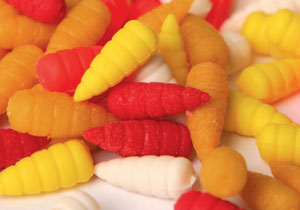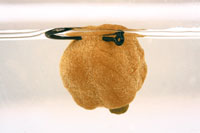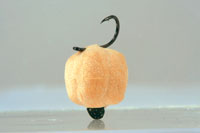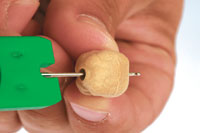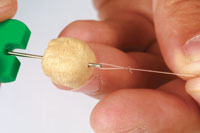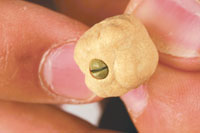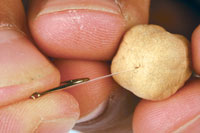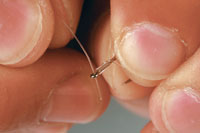Why Use Artificial Baits?
Durability is the key as is their ability to avoid problems from so-called nuisance species. A classic example would be when there are millions of small silver fish about when bigger creatures are your target.
On a river full of minnows, for instance, live maggots are attacked constantly, whereas rubber maggots are left alone. There are also more and more venues, like the Great Ouse and the Basingstoke Canal, that have real problems with crayfish. Leger a worm bait on a venue like this and it will last mere seconds while fake baits will be left well alone.
Artificial baits are also a real boon for the long-stay angler targeting big fish. You can be sure that even if your bait is attacked by unwanted small fish, it will remain completely intact until your target big fish comes along.
Do They Work?
There is no doubt that many, many quality fish are taken on artificial baits.
The most popular bait of all is artificial corn and this is readily taken by fish like tench, carp and bream, both in daylight and, perhaps surprisingly given that it’s a visual bait, at night. Regular readers will have noted that Ian Welch is among the many tench specialists who use the artificial casters when fishing for the breed (see Critically Balanced panel).
The artificial maggots are used extensively by river anglers who target big barbel and chub; both species love this bait but real maggots are too quickly destroyed by small river species. The fake pellets can be fished by anglers for long periods when the real thing would break down within a couple of hours.
Feeding With Artificials
The idea is to persuade the fish to take anything that looks like the actual bait without feeling the need for a close inspection.
Artificial corn or maize works very well over a bed of pellets with a few grains of corn added, or over a mixed particle bed of feed including some maize. And rubber grubs are very effective over a bed of dead maggots fed in a PVA bag, especially in winter.
But don’t dismiss catching on a bait out there on its own; Matt Hayes’ personal best carp of 44lb came on a couple of pieces of artificial corn cast out into an area with no feed in it.
Rules And Regulations
Not all venues allow the use of artificial baits and you need to check their rules before using them.
You can use artificial baits on all almost all river and canal venues, and most big carp waters, but many commercial stillwaters will have stringent rules against the use of baits like fake corn, bread and luncheon meat.
Also, National Federation of Anglers rules do not allow the use of any form of imitation baits in matches.
Sinking Or Floating?
Until quite recently most of the artificial corn and pellets you could buy were floating, used either popped-up off the bottom, or as a floating or sub-surface bait.
However, demand for sinking artificial baits was fuelled by the underwater Korda videos which showed fish definitely shying off baits popped-up over a bed of feed. When fish like carp get their noses into the bottom of a bed of feed you don’t want the bait popped-up at all.
You can now buy sinking artificial corn and pellets which sit in amongst the loose feed. The Berkley Gulp! worms and mini worms, as well as the Power Bait bloodworm, maggots and pinkies all sink. The Enterprise maggots and casters are buoyant or sinking.
Critically Balanced
Many anglers like to fish cocktails to create a critically balanced bait which wafts up if a fish swims past.
Some of the floating corns are not ultra-buoyant anyway, and the addition of a real piece of corn as a cocktail counterbalances the buoyancy and creates a critically balanced hook bait that’s very easily sucked in by a feeding fish. Indeed, a size 10 hook may be enough to sink a grain of artificial corn (see our Sink Test panel).
A popular tench bait outlined in Ian Welch’s Tench Guide in our August issue is to Superglue two artificial casters onto a hair and then glue two real casters either side of these. These fake buoyant casters neutralise the weight of the hook to create a deadly and critically balanced hook bait.
Some readers may have seen the maggot clips that allow anglers to fish up to 20 maggots at a time in a bunch. A good tip to counterbalance the weight of the clip is to add two of the buoyant rubber grubs before adding the live ones.
Using Artificials Safely
The use of artificial baits is contentious in some quarters. If they come off the hook they will not be broken down by the fish’s digestive system if swallowed – and, because they are also unable to pass them, it is believed this may ultimately kill the fish.
At tcf we believe this is only likely to happen if extremely large hook baits are used, such as a fake 18mm pellet or a very large chunk of hard, fake bread.
The vast majority of fish will sense something is wrong with the bait and spit it out rather than swallow it right down. However, it’s crucial that, if you are going to use these baits, you know how to hook them effectively and securely so they don’t come off.
Although most are tough, side-hooked baits can still fall off and side-hooking them can result in lost fish due to masking part of the hook. The safest option is to hair rig the baits wherever possible – many products have instructions on the packaging about how to do this. The baits are all tough and a robust baiting needle should be used along with a large hair stop to make sure the bait stays on.
Enterprise has just bought out a large hair stop in the shape of a mini piece of corn, which is ideal for visually tipping your baits and keeping them on the hair.
The Point Of Artificial Bread
Anyone who has fished bread on the top for carp on waters holding lots of small fish will know that, almost as soon as it’s in the water, the smaller fish start to whittle it down. The bait also takes on water quickly, becoming less buoyant, and never survives more than one cast.
With artificial bread there are no such problems. Unlike real bread, the artificial version will retain its buoyancy for long periods and can be left out for long periods.
The Enterprise version is very soft while Partridge artificial bread is harder, so don’t fish huge chunks of this.
Note that if there are a lot of water birds in the venue surface fishing with bread is not advisable.
Flavouring Artificials
Many of the artificial baits outlined in this guide carry flavours well, but you must use the right kind.
Oily flavours will only coat the baits; alcohol flavours will flavour them but create a ‘harsh’, blatant flavour that while attracting fish can also put them off.
The best flavour we’ve come across for artificial baits is Peach Ade from Mainline. Ade is a naturally sweet flavour and when ‘cut’ with another flavour has a much rounder ‘note’ without the harshness of alcohol-based flavours. Just put a few different artificials in a sealable tub, add 5-10ml of flavour, shake and leave. The good news is that Peach Ade won’t damage or discolour your artificial baits, and the longer you leave them the better. We know of specialists who have kept their baits flavouring in this stuff for over two years!
If you do use an alcohol-based flavour, soften it up by mixing it with a syrupy flavour – this will take away the sharpness.
Artificial Intelligence
The tcf team takes an up close and personal look at some of the best fake baits on the market.
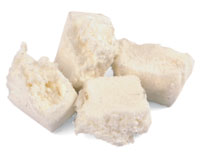 |
Enterprise Imitation Bread
Soft, buoyant and spongy and takes on flavours well. Comes already cut into four chunks to ensure you don’t use too big a piece.
tcf: Mainly a surface bait but small pieces popped up just off bottom can be deadly in clear water. |
|
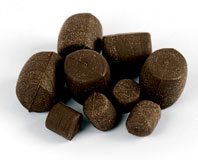 |
Enterprise Sinking Pellets
Soft sinking pellets infused with a seafood flavour. You get five 6mm and five 10mm pellets in a pack.
tcf: These look the most realistic of the ones we tested. |
|
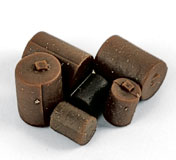 |
CFS Floating Pellets
Hard plastic fake floating pellets which can be fished on surface or popped-up. You get three 4mm and three 6mm pellets in a pack.
tcf says: Harder than, and not as realistic as, the Enterprise ones, but smaller and the range goes down to 4mm. |
|
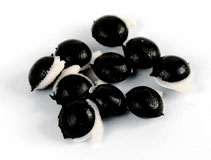 |
Enterprise Artificial Hemp
Not that realistic looks-wise, but can be sidehooked and offers the interesting option of popping-up a grain of hemp with light hook patterns.
tcf: Sinks under the weight of a size 17 B711 or a size 18 G-Point Carp Barbless. Floats with a size 18 B911 or lighter. |
|
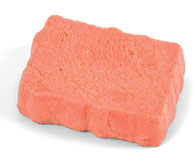 |
Enterprise Imitation Luncheon Meat
Very buoyant, soft and spongy with a sweet smell, and takes on flavours quite well. Best hair rigged.
tcf says: Can be popped-up or combined with real meat to produce a critically balanced bottom bait. |
|
 |
Powerbait Power Bloodworm
Very realistic with a rubbery texture and available in strips. Almost neutral buoyancy – it sinks under the weight of a fine wire size 24 hook.
tcf: Would be brilliant for catching small silver fish fast and shallow as it negates the need to rebait. |
|
 |
Powerbait Power Maggots
Comes in strips and coated with what Powerbait call their ‘proven most powerful scent and flavour formula’. Available in white, red, yellow, bronze, pink, brown and smoke colours.
tcf says: Soft and sinks at the same rate as real maggots. Smaller than the Enterprise rubber grubs. |
|
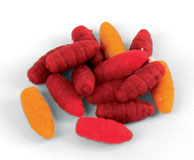 |
Enterprise Rubber Casters
These are being used by many tench and bream specialists, typically glued onto a hair and fished over bed of real casters. Twenty in a packet.
tcf says: Buoyant but will sink under the weight of a size 17 B711 hook. We also found them quite hard. |
|
 |
Powerbait Power Corn
Rubbery, sinking corn with an oily coating and a slightly spicy aroma. Available in yellow and red strawberry. Comes on strips with 60 grains in a tub.
tcf says: Fast-sinking but does waft up easily off the bottom. |
|
 |
Enterprise Rubber Grubs
Bigger than real maggots and much softer than the Enterprise Rubber Casters. Available as floaters or sinkers. Twenty in a packet.
tcf says: Floaters are very buoyant – it takes a size 12 Drennan Super Specialist to sink them. Can be sidehooked. |
|
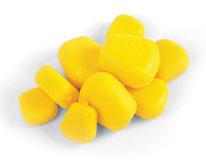 |
Enterprise Sweetcorn
Bright yellow pop-up corn. Best used with real grains on a hair to create neutral buoyancy baits. Available in mini and large sizes as pop-up and sinking baits.
tcf says: Very buoyant – even a size 10 Carbon Specimen cannot sink the large grains. Size 15 Super Specialist will sink mini grains. |
|
 |
CFS Corn
Large rubber fake corn which is ideal for popping up. Three dull yellow, three dull orange and three black grains in a packet.
tcf says: Like the Enterprise corn even a size 10 Carbon Specimen won’t sink these grains. |
|
 |
Enterprise Dog Biscuits
Counterbalanced by a shot so that the hook sits out of the water. Available in two sizes with the shot and hair-rigging instruction in the packaging.
tcf; Superb idea and the shot makes the mixer sit well down in the water so it looks natural. |
|
 |
Enterprise Sweetcorn Hair Stop
Grains of the buoyant mini corn with an integral groove so that it can be used as a large, visual hair stop. Available in yellow and neon. Twelve in a packet.
tcf says: New product and a great idea which can help you create a neutral buoyancy hook bait. |
|
 |
Carp Zoom Grub Ups
Very similar to the Enterprise grubs in shape and size, but less buoyant so allowing the use of smaller hooks. Available in three colours of either normal- or maggot-flavoured.
tcf says: A bit tougher and with a more obvious join than the Enterprise versions. Sinks under the weight of a size 16 Super Specialist. |
|
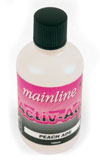 |
Mainline Peach Ade
Not an artificial bait as such but an excellent flavour which rubber baits pick up well and isn’t too harsh. Also comes in Trigger, Maple, Pacific Tuna and Strawberry.
tcf says: You can leave artificial baits soaking in this stuff indefinitely. Recommended. |
|
The Caster Cocktail
Casters are great bait for quality fish, but the problem with them is that they are all-too-easily ‘smashed’ up by small fish before the specimens can get a look in. This rig allows you to retain the attraction of real casters. Combined with the hardiness of artificials, they have the added bonus of creating buoyant bait that pops up just above your feed bait and is very easily sucked in. We used the Enterprise Tackle buoyant rubber casters and the hook is a size 12 Drennan Barbless Super Specialist.
 |
Step1
Tie your hook on using the knotless knot and leave a longer-than-normal hair off the bottom of the knot. |
|
 |
Step 2
Add a dab of superglue to one of the artificial casters – these are the Enterprise ones. |
|
 |
Step 3
Lay the line across the glue and hold another of the artificial casters firmly onto the first. |
|
 |
Step 4
After around 20 seconds the artificial casters should hold firmly on the hair. |
|
 |
Step 5
Now add another dab of superglue onto one side of the glued-together artificial casters. |
|
 |
Step 6
Then push a real caster onto the glue as shown. |
|
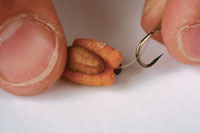 |
Step 7
Do the same on the other side… |
|
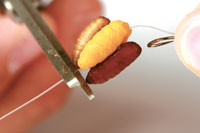 |
Step 8
… before trimming off the excess length of the hair. |
|
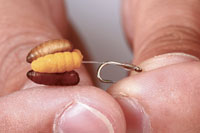 |
Step 9
The finished article, a buoyant cocktail of fake and real casters. |
|
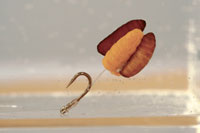 |
Step 10
As you can see, the weight of the hook is enough to hold the bait down – irresistible! |
|
The Maggot Clip
The maggot clip is a very recent development that allows the angler to easily fish a ball of maggots off a hair rig.
They are made by Korda and come in four sizes: extra small, small, medium and large.
We used the smallest one for this sequence, paired with a size 10 barbless eyed hook.
By using the buoyant rubber grubs in combination with real maggots, you can create an almost neutral buoyancy ball of maggots, which can easily be sucked up by the fish.
Meanwhile, the maggots wriggle to keep the bait moving and jumping around on the bottom, creating added attraction.
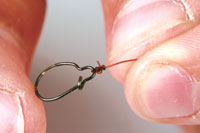 |
Step 1
Tie the end of your hooklength to the top of the maggot clip using your favourite knot. |
|
 |
Step 2
Attach the eyed hook using a knotless knot leaving a hair about an inch in length. |
|
 |
Step 3
Hook the rubber grubs on first, just like real maggots – be sure to use the floating ones. |
|
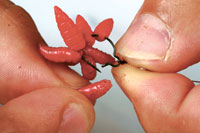 |
Step 4
Three artificials plus four or five maggots are about right on the small clips. |
|
 |
Step 5
The finished article is easily sucked in and always on the move – deadly! |
|
|
Artificial Mixers
 |
One of the main advantages of an artificial mixer is that it will remain very buoyant. Conversely, a real one will take on water and sink further. It’s better to retain the buoyancy because fish need to suck harder to get it into their mouths. Thus, they are more likely to take the bait properly and hook themselves.
Without doubt, the best of the artificial mixers are the relatively new counterweighted baits, each of which features a hole on one side for a split shot. With the hook on the opposite side, the heavier split shot forces the mixer to sit on the bottom with the hook top side up out of the water and out of sight of the fish – which should mean you get more takes. The hook is side hooked into the top side, but only after being placed onto a long hair (see sequence).
The early versions of these were too buoyant, but the latest ones we’ve seen do sit well down in the water to mimic the loose feed. In truth, it’s not all that easy to set these up correctly. Many anglers have tried them only to find that the mixer turns over on its side and the hook is visible to the fish. A size 10 hook is the right one for this rig, but for it to work it’s crucial that the hook is lighter than the shot in the bottom.
Lighter-gauged wire hooks such as the Drennan Carbon Specimen, the Fox Series 2 and the Drennan Specimen Barbless are needed. The other trick is not to use too stiff a hooklength line (a stiff hook link will tip the mixer over). A soft and supple hooklength (something like an 8lb Drennan Double Strength is perfect) should allow the mixer to sit perfectly in the water. To get it right, test it in the margins before casting out.
As you will see from the pictures, because you get an offset hook when using the knotless knot the line actually lifts off the mixer when mounted correctly and there is no line touching the water near to the mixer. However, if the hook comes out, you still have a secure hair connection and there’s no chance of leaving the bait out there when you reel in. You know it makes sense!
How To Hook The Counterbalanced Mixer
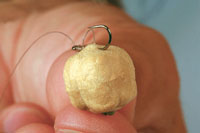 |
Step 15
Pull the hooklength knot into the mixer so that the hook sits proud. |
|
 |
Step 16
The imitation mixer should sit like this, with the hook and hooklength out of sight of the fish. |
|




